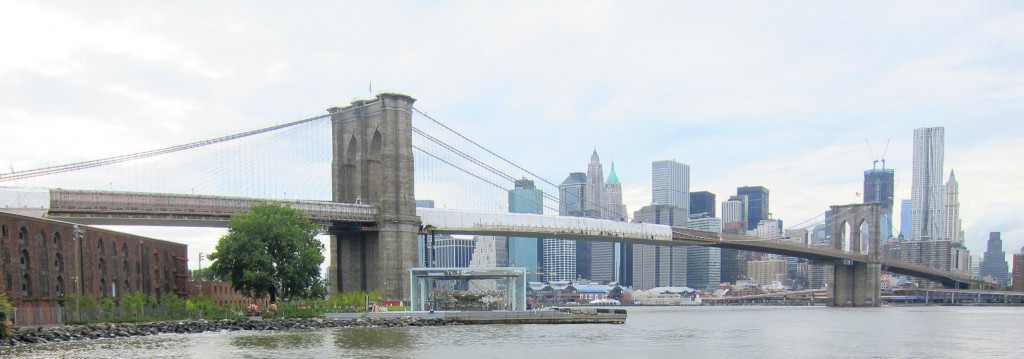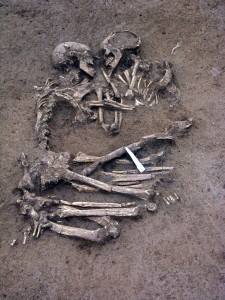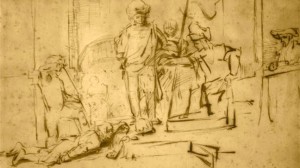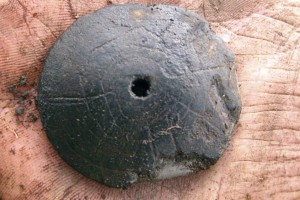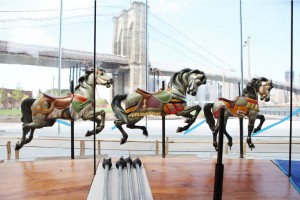 On Friday, September 16, a carousel built by the Philadelphia Toboggan Company (PTC) in 1922 for the now-defunct Idora Park in Youngstown, Ohio, will again delight ladies and gentlemen and kids of all ages, only now their view will be of the East River, Brooklyn Bridge and the Manhattan skyline.
On Friday, September 16, a carousel built by the Philadelphia Toboggan Company (PTC) in 1922 for the now-defunct Idora Park in Youngstown, Ohio, will again delight ladies and gentlemen and kids of all ages, only now their view will be of the East River, Brooklyn Bridge and the Manhattan skyline.
Idora Park officially closed its doors after 85 years on Labor Day 1984, after a fire in April devastated much of the park, including its famed 1929 wooden coaster, The Wild Cat. The carousel, scorched but intact, sold at auction October 20th of that year. It would have been just another sad story of how the decline of the urban manufacturing base decimated a local business until it was sold for scrap, but this merry-go-round got lucky. Each of its 48 horses and 2 chariots were sold individually, but at the end of the auction all the bids were tallied up and a single buyer was offered the opportunity to take the entire carousel for the combined sum. New York real estate developer David Walentas and his wife Jane bought Philadelphia Toboggan Company #61 for $385,000.
 They were in the market because Walentas was developing a waterfront shopping complex in the Brooklyn neighborhood known as DUMBO (Down Under Manhattan Bridge Overpass). A rounded riverside spot seemed like the perfect place for an antique carousel so they went and bought them one. They hired a specialized company to dismantle PTC #61 and ship the whole shebang to Brooklyn, where Jane, who has a master’s degree in fine art, began researching carousel restoration.
They were in the market because Walentas was developing a waterfront shopping complex in the Brooklyn neighborhood known as DUMBO (Down Under Manhattan Bridge Overpass). A rounded riverside spot seemed like the perfect place for an antique carousel so they went and bought them one. They hired a specialized company to dismantle PTC #61 and ship the whole shebang to Brooklyn, where Jane, who has a master’s degree in fine art, began researching carousel restoration.
Instead of outsourcing, Jane decided to take on the massive restoration herself. It’s an incredible story of obsession and dedication. First she documented like crazy, taking pictures and samples and notes on the main parts of the carousel. The original paint was unsalvageable so she sent the parts to a chemical stripper so the dozen layers of overpaint could be removed. Jane had a carpenter repair the parts, prime them and then set them aside in storage to focus on the stars of the show, the horses and chariots.
I spent years, mostly alone, scraping the many layers of park paint to reveal the original palette and beautiful carvings. I had hoped to be able to keep the horses in their factory paint, but was eventually convinced that it was not possible. Much of the paint was fragile and the surface of most of the horses was rough and needed too much repair to have been left as they were. Once again, I did precise matches of the factory colors, and traced, drew and photographed everything I uncovered. I worked scraping paint off the horses, sporadically over the course of about 16 years.
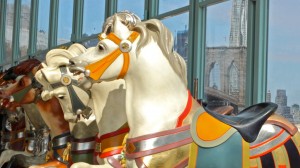 In June of 2004, the decades of work came to a head. She moved into a new studio, hired more help and set about doing all the repairs to the individual horses. Once repaired, they were repainted with painstaking fidelity to the factory original look, and then, because rich people are crazy, Jane took it a giant mommy step further and gilded all the horses’ metallic fittings and decoration, originally aluminum leaf or aluminum leaf with a gold wash, in freaking palladium and 24 carat gold. She also hired a luxury car customizer from Mercedes-Benz to do all the hand pin striping work on the horse bridles.
In June of 2004, the decades of work came to a head. She moved into a new studio, hired more help and set about doing all the repairs to the individual horses. Once repaired, they were repainted with painstaking fidelity to the factory original look, and then, because rich people are crazy, Jane took it a giant mommy step further and gilded all the horses’ metallic fittings and decoration, originally aluminum leaf or aluminum leaf with a gold wash, in freaking palladium and 24 carat gold. She also hired a luxury car customizer from Mercedes-Benz to do all the hand pin striping work on the horse bridles.
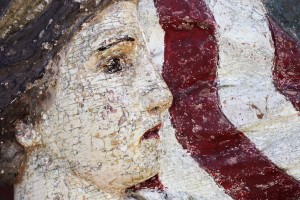 The two chariots, “Cherub” and “Liberty” she was able to keep in their original paint. After removing all the coats on top of it, the original paint was sturdy enough to stand on its own with just a little infilling. Although there’s a noticeable cracklure over the chariots’ surface, they still look fantastic even next to the freshly repainted ponies.
The two chariots, “Cherub” and “Liberty” she was able to keep in their original paint. After removing all the coats on top of it, the original paint was sturdy enough to stand on its own with just a little infilling. Although there’s a noticeable cracklure over the chariots’ surface, they still look fantastic even next to the freshly repainted ponies.
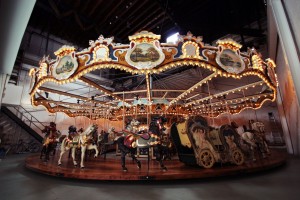 In 2006, the carousel was ready to be put back together and on display. Over the years the shopping center project had been scrapped to be replaced with a Empire Fulton Ferry Park, so the Walentas set up the carousel, now renamed “Jane’s Carousel” in honor of its obsessively loving foster mom, in another of their properties, a converted spice warehouse in the DUMBO neighborhood where people could see it among the art galleries but not ride it.
In 2006, the carousel was ready to be put back together and on display. Over the years the shopping center project had been scrapped to be replaced with a Empire Fulton Ferry Park, so the Walentas set up the carousel, now renamed “Jane’s Carousel” in honor of its obsessively loving foster mom, in another of their properties, a converted spice warehouse in the DUMBO neighborhood where people could see it among the art galleries but not ride it.
After some struggling with various committees, entities and civic groups, the Walentas got the nod to install the carousel on the waterfront in front of the Civil War-era Tobacco Warehouse. They hired French architect Jean Nouvel to design a suitable pavilion to house it and he created a $9 million transparent acrylic jewel box that would show off the beauty of the carousel during the day, show the riders a most spectacular view and that would at night be lit so that the horses cast huge shadows on the white floor-to-ceiling window shades. They also donated $3.45 million to the park for landscaping and nighttime lighting that will allow the park to stay open until 1:00 AM.
Oh, and they donated a 1922 Philadelphia Toboggan Company carousel with palladium and 24 carat gold fittings.
Now the jewel box is done, the parts and horses have been moved in, and as of Friday, Jane’s Carousel will be open from 11:00 a.m. to 7:00 p.m., every day except Tuesday. A ride costs $2, children under three ride for free.
